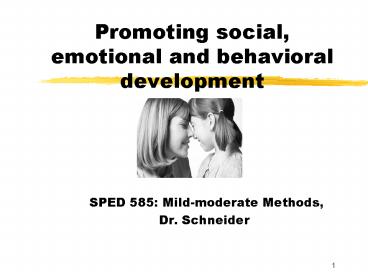Promoting social, emotional and behavioral development - PowerPoint PPT Presentation
1 / 24
Title:
Promoting social, emotional and behavioral development
Description:
(1) What are some ways to assess social, emotional and ... Bulemia/anorexia nervosa. Other: 11. interventions: Emotions. Biblio-therapy. Attribution training ... – PowerPoint PPT presentation
Number of Views:95
Avg rating:3.0/5.0
Title: Promoting social, emotional and behavioral development
1
Promoting social, emotional and behavioral
development
- SPED 585 Mild-moderate Methods,
- Dr. Schneider
2
Important issues
- (1) What are some ways to assess social,
emotional and behavioral challenges? - (2) What are profiles of some social, emotional,
and behavioral challenges of students with
mild-moderate and severe disabilities? - (3) What are some related interventions?
3
Assessment issues
- (1) observer-rater instruments
- Observer completes a checklist or rating scale
(frequency documentation) - (2) adaptive behavior instruments
- Measuring an individuals way to adjust to
changes in environment
4
Assessment issues
- (3) self-report instruments
- Q-Sort Technique
- To identify areas for behavior modifications
(real self vs. ideal self) for Elem. Students,
parents and teachers -gt compare - Student sorts 25 statements into a pyramid from
most like me to most unlike me - Informal Self-report techniques
- Teacher-made checklist that students check off
(yes/no true/false just check mark) - Open-ended surveys (I get mad when)
5
Assessment issues
- (4) Socio-metric techniques
- Mainly to assess social skills and related
challenges - Peer nominations
- Peer-ratings
- Peer Assessment
- Socio-grams
6
Assessment issues
- (5)Naturalistic observations
- Behavior
- Environment
- Teacher-student interaction
- Environment
- Role Play Assessment
7
Profiles interventions Social Skills
- PROFILES
- Nonverbal Language Disorders
- Aspergers
- Autism
- Severe,non-verbal disability
- Abuse-related withdrawal or overreaction (anger,
depression, loss of speech) - Other
8
Profiles interventions Social Skills
- INTERVENTIONS
- role plays
- Autism training programs
- Biblio-therapy
- Group games turn taking, learning to lose
- Free food
- Single and group therapy
- Other
9
Profiles interventions
- Emotional, behavioral and social issues are
usually interrelated into a complex web to
decipher for the educator and student in a step
by step fashion. - The following separate listing is only done for
organizational reasons. The educator must
patchwork elements together and make best
possible choices.
10
Profiles Emotions
- Regularly under-identified
- All to be considered on continuum
- Depression/ bi-polarism
- Anger opposition-defiance
- Anxiety/lack of anxiety
- Bulemia/anorexia nervosa
- Other
11
interventions Emotions
- Biblio-therapy
- Attribution training
- Life-space interviewing
- Reality therapy
- Improving accepting authority figures
- Enhancing self-concept
- Role playing
12
Profiles Behavior
- AD(H)D
- Defiance disorder
- Shyness
- Eye contact disorder
- displayed through avoiding eye contact, staring,
rapid blinking, eye twitching, abnormally
wide-open eye lids, scanning people up and down
as though they are specimen.
13
Profiles interventions Behavior
- PROFILES
- Other
14
Interventions Behavior
- Positive reinforcement
- Contingency contracts
- Token systems
- Extrinsic reinforcement
- Punishment prevention strategies
- Punishment strategies
- Non-verbal Language Training
- Other
15
Interventions Behavior
- Non-verbal Language Training
- Aspects to make explicit
- Eye contact
- Gestures emblems ?
- Facial expressions (eye whites and pupils,
eyebrows, eyelids, nose cheek, mouth chin
16
Interventions Behavior
- Non-verbal Language Training
- Aspects to make explicit
- Eye contact
- Gestures emblems ?
- illustrators (movements that support what
speakers says e.g., signaling size of box),
regulators (movement that signals change in
speakers role), adaptors (speakers emotional
state like scratching head), affect displays
(very direct display of speakers emotional state)
17
Interventions Behavior
- Non-verbal Language Training
- Facial expressions Use of eye whites and pupils,
eyebrows, eyelids, nose cheek, mouth chin - Postures are different from gestures as they can
be seen from further away provide general clues
about persons character, mood gestures tell
more about intensity of emotion or conversation
flow.
18
Interventions Behavior
- Non-verbal Language Training Paralinguistic
factors factors about vocalization that has
nothing to do with the words you use - Volume using voice from whisper to shouting
- Tonecongested or too nasal-speech therapy
- Pitch The amplitude of high and low of voice
must be age appropriate - Speed how fast you talk
- Speaking style pronunciation, dialect
19
Interventions Behavior
- Non-verbal Language Training Paralinguistic
factors cont. - Stress highlight important information, words
- Laughter inappropriate (too much or none or in
inappropriate point in time) is to signal
enthusiasm, joy about topic - Response Time Students take too much or too
little time (jump in) to respond - Speech errors speech therapist collaboration
- Context helps tell interpret expressions
20
Interventions Behavior
- Non-verbal Language Training Paralinguistic
factors cont. - Personal appearance
- Personal space touch culture specific
- Intimate 0-18 (relatives, friends, lovers)
- Personal1.5-4 (you can touch partner)
- Social 4-12 (business situation)
- Public 12-25 or more
21
References
- Non-Verbal issues
- LoGuides, C. Warner, M. (2003). The nonverbal
language kit. East Moline, ILLinguisystems.
(cards, game with instructor manual ages 7-16
Aspergers
22
Facial expressions
23
Posture or gesture?
24
Posture or gesture?

